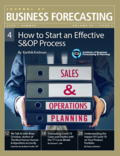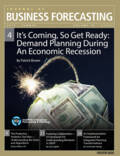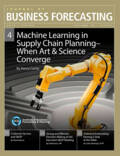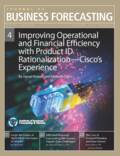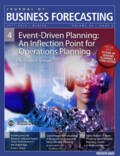 Cart
(0)
Sign In
Cart
(0)
Sign In
- Type of content
- All Knowledge
- Analytics
- Process
- Technology
- People
17
Articles Available
As Covid-19 abates and we emerge from lockdown, businesses are reopening amid an entirely different set of circumstances. Volatility will be around for a while, and supply chains must react accordingly, with specific functions needing to reassess how they add value in this new environment, and what their day-to-day operations should be. Here I present recommendations for supply chain functions to mitigate risk and ensure efficiency going forward based on the 3 V’s: Visibility, Velocity, and Variability.
Summer 2020
3
This article discusses the importance of establishing strong links between demand planning and inventory management processes. Several steps in the Sales & Operations Planning (S&OP) process can be more effective if this relationship is managed well. For example, linking expected demand patterns with a review of stocking risks and an evaluation of the best stocking strategy. It shows “how-to” examples for integrating demand planning with inventory control to gain a better overall balance across objectives leading to improved financial performance.
Spring 2020
05
This article deals with the differences between ‘responsible’ versus ‘ethical’ supply chains. It is meant to be controversial. I believe that businesses need to address the seemingly uncivil public culture we are experiencing today, in order to ensure that plans, forecasts and decisions are made collaboratively, as well as consensus-based. We have started to see instances in which employees’ so-called ‘ethical’ opinions about politics and value-systems have fostered dysfunction in some high-profile workplaces. It is important for management to address these issues as they arise, so that ‘responsible’ decisions are made in the interest of the whole company.
Fall 2019
3
The digital economy refers to an economy that is based on digital computing technologies where business is conducted through online and mobile devices using the internet-of-things (IoT). In the digital economy, value is created through the technology-enabled links between people, machines, channels and organizations. All this is giving rise to an awareness and willingness to apply analytics to everything, not just to strategic initiatives, but to day-today tasks. Advanced analytics aided by machine learning algorithms will automate the repetitive work demand planners do regarding managing data and information as well as uncovering key insights allowing them to work smarter and more efficiently. As such, digitalization of the supply chain will require companies to manage product replenishment based on actual consumption rather than transactions.
Summer 2019
5
Since 2013 I’ve been writing a series of articles in my Insights column, in Supply Chain Management Review (SCMR) magazine, about e-tailing. It chronicles the evolution of e-commerce vendors—mostly aboutmarket-leader Amazon - as they’ve captured more of the retail business from the traditional brick-and-mortar retailers, largely market-leader Walmart. This column draws from the latest in the SCMR series because it focuses on ‘successful’ inventory management planning, buying, and fulfillment processes. In short, Amazon excels in operating a ‘responsive’ supply chain, while Walmart’s success is as an ‘efficient’ one. In both cases, their strengths become their weaknesses when competing for the other’s core business.
Spring 2019
3
Quick Response Forecasting is a forecasting process that can incorporate information quickly enough to act upon by agile supply chains. The challenge most companies are experiencing is the length of time it takes for the demand forecasting process to incorporate rapid changes or short-term spikes in demand. Many supply chains are still too sluggish, and not agile enough to take full advantage of demand forecasts that include short-term spikes. Forecasting at the edge for real-time demand execution using event stream processing (ESP) combined with machine learning (ML) to analyze demand as it is generated at the store device can eliminate the noise decreasing latency in the decision-making process.
Spring 2018
This article presents the opportunities for demand planning and associated functions as supply chain digitalization emerges, and the challenges associated with fully realizing its benefits at the enterprise level, for example, through enhanced Integrated Business Planning (IBP). It introduces a change approach, based on the Tipping Point insights and principles explored by Malcolm Gladwell that provide some practical illustrations of how this approach can be applied to support change programs in this field.
Winter 2017-2018
This column discusses a lesson to be learned from Sears of long ago when it was a bi-channel retailer. The company successfully operated its legacy catalog business in conjunction with store operations as two separate supply chains. The column also discusses that many service arms of durable-product companies typically do the same in order to balance short-term sales versus long-term service-customer satisfaction. Forecasters and planners finding themselves in these situations may need to support multiple ‘efficient’ versus ‘responsive’ supply chains.
Fall 2017
An important undertaking for any company to serve its customers is to determine how much inventory is necessary to satisfy customer demand. This article reviews some of the key supply and demand elements influencing this decision. It explores these in the context of their expected levels and the importance of considering variation around their expected levels. It further evaluates how well a widely used metric affecting the inventory decision actually affects the customer and the company—days of inventory on hand and or inventory turns.
Summer 2017
More than ever before, C-level Executives want their bottom line to be as profitable as possible. Ensuring both near-term and long-term profitability of a business will ensure the long term sustainability of the business. To maximize profits, executives must be diligent in cutting frivolous costs and boosting productivity among employees. This is an ongoing process that often faces many challenges. Everyone knows that increasing sales and margins increase profitability, but there are several key operational strategies that can be utilized to increase profitability by as much as 50%. Integrating these operational strategies with S&OP yields even greater benefits.
Spring 2017
Time series forecasting has evolved in a big way since 1822, when Joseph Fourier fi rst conceived of the mathematical analysis of historic time series data. Today, more complex time series models and forecasting tools continue to fuel the pursuit of improving forecast accuracy. Despite all the advancements in time series models, forecast accuracy remains a challenge.
Fall 2016
5
Having your company’s money invested in the right inventory is critical. Modern supply chains are much more complex, product life cycles are shrinking, and “Risk Management” is the new buzzword. There are too many opportunities for things to go wrong. No one can afford to have money tied up in the wrong product mix or in excess inventory; it’s the kiss of death and everyone knows that, right?
Fall 2016
3
The digital revolution has affected all aspects of business, including supply chains. The Internet of Things (IoT), with its network of devices embedded with sensors is now connecting the consumer to the factory. Technologies such as RFID, GPS, event stream processing (ESP), and analytics are combining to help companies to transform their existing supply chain networks into more flexible, open, agile, and collaborative digital-driven models. Digital supply chains enable business process automation, organizational flexibility, and digital management of corporate assets.
Summer 2016
3
My last column in the Journal of Business Forecasting (Spring 2016), titled “Execution Needs the S&OP Plans,” discussed the need to synchronize supply-demand execution operational plans with the tactically based Sales & Operations Planning (S&OP) process plans. The main purpose of this is to help align daily operations—such as those that take place on the plant floors and within the distribution centers—with the plans that have been developed to meet the operational performance goals that drove the S&OP plans. This helps operations managers to act in accordance with financial and various operational objectives.
Summer 2016
4
Today, we live in a polarized world that divides family members, friends, and business colleagues. It affects everything we do from the way we communicate with one another to how we handle business challenges. I have seen long-time business colleagues have passionate discussions defending their supply chain position regarding what adds more value—demand or supply. As a result, we now work in what I refer to as the “polarized supply chain,” where you are a believer in either supply or demand. Sound familiar? We get caught up in what we are comfortable with, or what we believe is the “holy grail” to fixing the inefficiencies in the supply chain. The pendulum seems to swing back and forth from decade to decade, focusing on supply or demand “processes and technologies” with little emphasis on people (skills and changing behaviors), and virtually no attention to predictive analytics.
Spring 2016
4
Remember, our discussion revolves around the supply chain and the S&OP process operating in a global environment. With that said, there are more and more sources of uncertainty, complexity, and risk within our supply chains and the S&OP process. Why?
Winter 2015-2016
5








